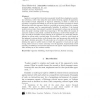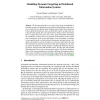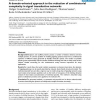334 search results - page 28 / 67 » Survey of trust models in different network domains |
AAMAS
2005
Springer
13 years 7 months ago
2005
Springer
Agents in a competitive interaction can greatly benefit from adapting to a particular adversary, rather than using the same general strategy against all opponents. One method of s...
SBRN
2008
IEEE
14 years 2 months ago
2008
IEEE
In this work, we propose to use the Zoomed-Ranking approach to ranking and selecting Artificial Neural Network (ANN) models for time series forecasting. Given a time series to fo...
AIPS
2008
13 years 10 months ago
2008
In the last decades, there has been an increasing interest in the connection between planning and constraint programming. Several approaches were used, leading to different forms ...
KESAMSTA
2010
Springer
13 years 9 months ago
2010
Springer
Abstract. We describe and model a new aspect in the design of distributed information systems. We build upon a previously described problem on the microlevel, which asks how quickl...
BMCBI
2006
13 years 7 months ago
2006
Background:Receptors and scaffold proteins possess a number of distinct domains and bind multiple partners. A common problem in modeling signaling systems arises from a combinator...



